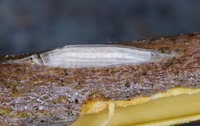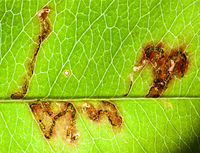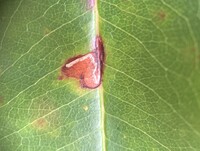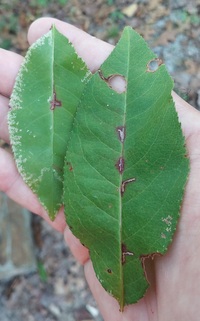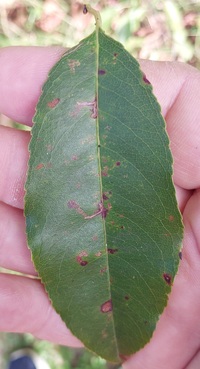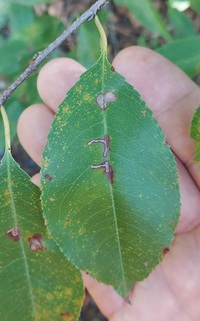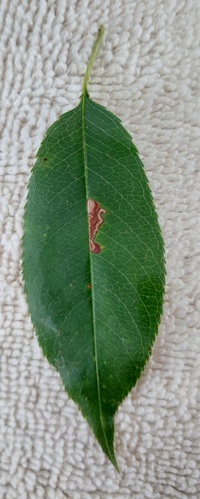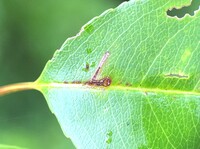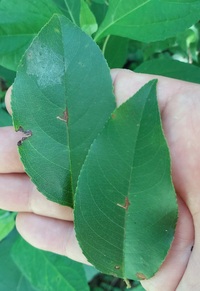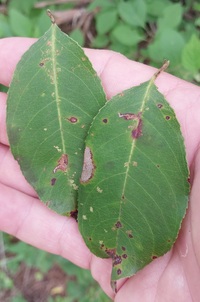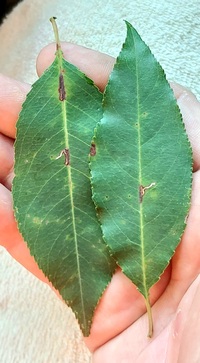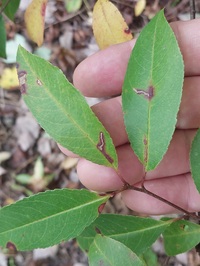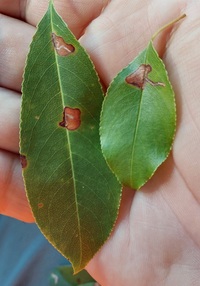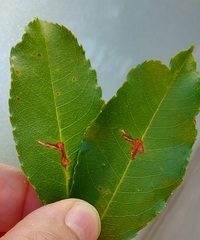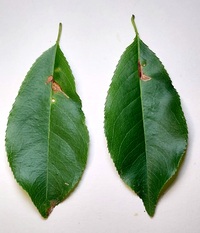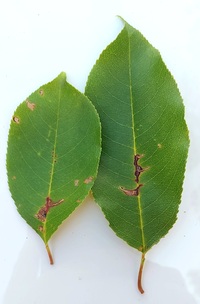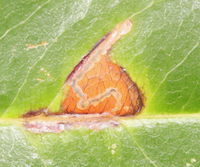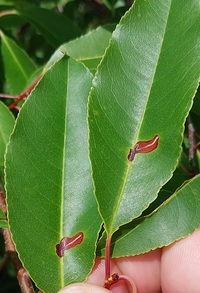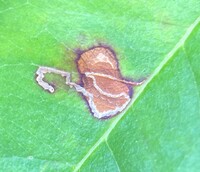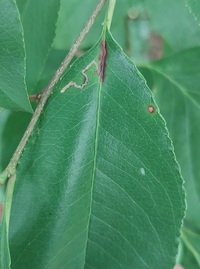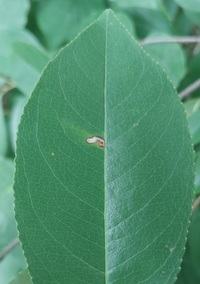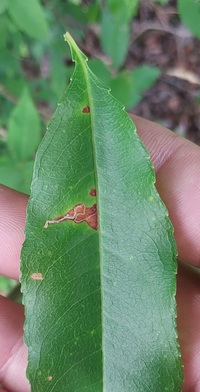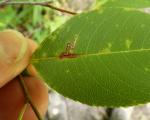Identification
Adult Markings: This is a minute brownish white moth with a dark oval patch on the dorsal surface of the forewings when held at rest. The ground color of the forewing, the head, and thorax is white and dusted with brown scales. The anterior half of the wing is usually noticeably lighter than the posterior half. The following detailed description is based on that of Braun (1963). The face is creamy white and minutely speckled with brown. The tuft varies from white, with a few brown hairs centrally, to predominantly brown. The eye-cap is creamy white, with minute brown-speckling. The basal two-thirds of the antennal stalk is evenly and regularly annulated with alternating white and brown rings. In the apical third, there are two dark brown sections with white rings between them (one long; the second relatively short) that are separated from the evenly annulated basal two-thirds and apex. The thorax is white with either minute faint brown speckling, or dense brown dusting. The ground color of the forewing is creamy white, and more or less obscured by the slight to dense dark dusting of brown-tipped scales. The basal half of the wing is paler than the outer half, and sometimes noticeably contrasts with it. A line of dark scales is located along the costa that angles across the wing near the middle of the costa to join a dark apical patch near the anal angle. This streak sometimes fades out before reaching the termen. Other areas of dark scales are often evident along the costa at one-third (often forming a short oblique wedge-shaped mark), along the fold, and along the base of the dorsum. On the middle of dorsum there is a conspicuous dark brown oval spot, sometimes encircled by whitish scales, that bears a patch of blackish raised scales near its inner edge. A dark brown apical spot is usually evident that is typically preceded by a pale half ring, which may be obscured by dark dusting. The cilia has a line of dark-tipped scales that extends from the apex to the tornus. The hindwing and cilia are pale to dark grayish ocherous, while the legs are creamy white, with some fuscous shading and fuscous-tipped tarsal segments. Bucculatrix pomifoliella is similar to B. ainsliella , but the basal half of the wings are paler than the outer half (often distinctly contrasting). In addition, the white scales on the anterior and posterior margin of the semi-oval patch are reduced relative to those seen on B. ainsliella . Both of these species have a similar pattern of antennal markings that distinguish them from other members of this genus. Dissection may be needed in some cases to distinguish between these species.
Wingspan: 7-7.5 mm (Braun, 1963)
Adult Structural Features: The male and female genitalia, along with associated scale tufts and patches, are distinctive and are described and illustrated by Braun (1963). The following are her verbatim descriptions. Males: harpes with slight indication of lobes, but the parts fused and strongly sclerotized, the apex dark-pigmented, thus in ventral view concealing the thin membranous socii; vinculum greatly produced anteriorly to an acute rounded point and expanded at base into lateral wings, the outer margins of which are continuous with the tegumen; aedeagus enormous, tapering from the swollen base to acute tip, aperture elongate, cornuti a line of closely placed short spines. Scale sac broad and shallow, scales short. Females: ductus bursae sclerotized through segment 7, expanding before ostium, its ventral margin produced posteriorly to an acute angle; inception of ductus seminalis at anterior end of expanded section; signum longitudinally placed, obsolete dorsally, ribs diverging, a series of short acute spines on swollen bases.
Adult ID Requirements: Identifiable from photos showing hindwings, abdomen, or other specialized views [e.g., frons, palps, antennae, undersides].
Immatures and Development: The larvae mine the leaves of apples, cherries, and related species. The egg is deposited on the lower leaf surface next to the midrib. The hatchling initially produces a fine linear mine that follows the midrib or a major lateral vein. It then diverges away from the midrib or vein, where the track often becomes more convoluted. At the end of the third instar, the larva leaves the mine through the upper epidermis and produces a circular molting cocoon that is usually on the upper leaf surface. The last instars are green with reddish shading, and feed with rare exception on the upper side of the leaf where they eat out irregular patches of tissue (Slingerland and Fletcher, 1903; Braun, 1963). The lower epidermis is left intact, which then shows as an iridescent patch. The iridescent patches are characteristic evidence of the presence of B. pomifoliella (Braun, 1963).
Larvae ID Requirements: Identifiable from good quality photos, especially where associated with known host plants.

 »
»
